Clinical Trials in Vision Research
On this page:
- What is expected of volunteers in a clinical trial?
- What are the benefits of participating?
- What are the risks of participating?
- What if a volunteer’s health changes unexpectedly during the study?
- How is patient safety protected?
- What are the costs of a clinical trial?

Clinical trials in vision research have led to new medications, surgeries, and methods for disease detection.
If you or someone you know is thinking about taking part in a clinical trial, this booklet may answer some of your questions. Clinical trials in vision research have led to new medications, surgeries, and methods for disease detection that have saved or improved the eyesight of millions of people.
The National Eye Institute (NEI), one of the National Institutes of Health (NIH), conducts and sponsors clinical trials to discover safe and effective methods for preventing, diagnosing, and treating eye disease and vision loss. Established in 1968, the NEI is the largest sponsor of vision research in the United States.
Basics of Clinical Trials
What is a clinical trial?
Clinical trials are medical research studies in which people volunteer to participate. A clinical trial is used to evaluate the safety and effectiveness of a new procedure, medication, or device to prevent, diagnose, or treat an eye disease or disorder.

Clinical trials are medical research studies in which people volunteer to participate.
Generally, medical research begins in laboratories. After a treatment shows promise in the laboratory, it is tested in a study to determine if it will be beneficial for patients.
A clinical trial could test the effectiveness of a new drug for age-related macular degeneration or a new surgical technique for cataract removal.
What are the types of clinical trials?
The following four types, or phases, of clinical trials exist:
- Phase I clinical trials test a potential new treatment in a small number of volunteers to determine the best dosage and identify potential side effects.
- Phase II clinical trials test a potential new treatment in a larger number of volunteers to learn more about how the body responds to the treatment, the optimal dose of the treatment, and how the treatment affects a certain eye condition.
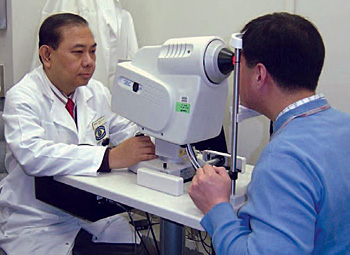

- Phase III and IV clinical trials may include hundreds or thousands of volunteers around the country. These studies compare a new treatment with existing treatments or no treatment to determine if the new treatment works better, the same, or not as well. Phase III clinical trials are conducted to get the new treatment approved by regulatory agencies. Phase IV clinical trials are conducted after approval to understand more about the treatment.
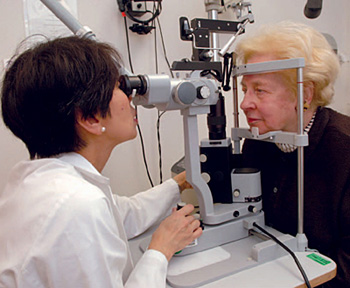
Clinical trials are controlled, meaning that researchers compare the effects of a new treatment with those of another treatment.
How a Clinical Trial is Conducted
The researcher in charge of a clinical trial is called the principal investigator. The person who makes the arrangements for your visits and explains how the study works is called the clinic coordinator.
Volunteers for clinical trials must meet certain eligibility criteria, which may involve age, type, and stage of a particular eye condition, and previous treatment for the condition.
If you are eligible for a clinical trial and you agree to participate, you will be asked to sign an informed consent. This document explains the main purpose of the study, the eligibility criteria, the treatment, the possible risks and benefits, your rights as a patient, and what researchers expect from you.
All of the doctors involved in the study follow a detailed treatment plan known as the study protocol. The protocol ensures that all participants are treated in a standard way.
Clinical trials are controlled, meaning that researchers compare the effects of a new treatment with those of another treatment. This is done by dividing study participants into groups. If you receive the new treatment, you are in the treatment group. If you are in the control group, you could receive the standard treatment for a particular eye condition. When a standard treatment does not exist, you may receive no treatment, a placebo, or a sham treatment.
A placebo may be used in clinical trials that test a medication. It is a harmless substance that looks like the real medication but has no direct effect on an eye condition. A sham treatment may be used in clinical trials that test a new surgery or device. A sham treatment, like a placebo, is safe and has no direct effect on an eye condition. Placebos and sham treatments are often used to understand both the positive and negative effects of a new treatment.
Researchers randomly assign participants to the treatment and control groups. In most studies, you have an equal chance of being assigned to each of the study groups. Though the study treatment may be effectivein some cases, new treatments may have serious side effects or may not be effective. During the clinical trial, there is no way for you or your doctor to know which study group will have the best response to treatment.
In a nonmasked trial, both you and your doctor will know your group assignment. In a masked trial, you will not know your group assignment. In a double masked trial, neither you nor your doctor will know your group assignment. Double masked trials help to ensure that the results will not be affected by what you or your doctor might think about the treatment.
How are clinical trials in vision different from other clinical trials?
Eyes are one of many body parts that come in pairs. This feature gives researchers some additional options when they design the study. If an eye condition affects both of your eyes, one eye might be placed in the treatment group for a study and the other may be in the control group. Generally, the eye that will be treated is randomly assigned.
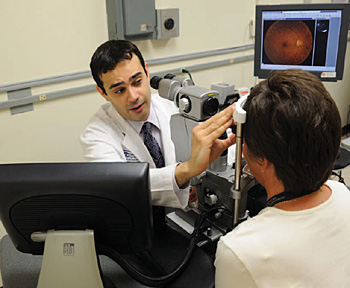
The success of a clinical trial often depends on learning what happens to participants over a long period of time.
Participating in a Clinical Trial
What is expected of volunteers in a clinical trial?
Participants in a clinical trial are expected to receive eye exams and other testing. You may need to take a new medication or undergo a new surgical procedure during the study. You may also be required to return to the medical facility for follow-up examinations. These exams help determine how well a treatment is working. Such follow-up studies can last for months or even years.
The success of a clinical trial often depends on learning what happens to participants over a long period of time. Only participants who continue to return for follow-up examinations can provide this important long-term information. These exams are essential for the success of the study. You should consider this when you are deciding whether to participate in the clinical trial. The study results will not be valid unless almost everyone who enrolls in the trial participates in the follow-up exams.
What are the benefits of participating?
Participants in NEI studies are monitored by a team of expert doctors, nurses, technicians, and support staff. By participating, you may be one of the first people to receive a promising new treatment. If the treatment is effective, it may improve your vision or prevent an eye condition from occurring.
If you are in the control group and the treatment is found to be safe and effective, you may be among the first to benefit from the treatment when the study ends.
All participants in clinical trials contribute to new knowledge that may help other people who experience similar eye problems. If you have an eye condition that runs in your family, your participation may also lead to better care for your family members.
What are the risks of participating?
Medical professionals have no method for predicting if a new treatment will work in a particular person. The treatment you receive could cause side effects that are serious enough to require medical attention.
Participants must understand that a new treatment may not work better than a standard treatment, may not work at all, or may be harmful.
What if a volunteer’s health changes unexpectedly during the study?
Your health is unpredictable. You could develop a serious medical condition during the study that is completely unrelated to your vision. If this happens, doctors may determine that it is in your best interest to leave the study. Your overall health always comes first in a clinical trial.
How is patient safety protected?
Before a clinical trial begins, researchers must get approval from an Institutional Review Board. This independent advisory group makes sure that a clinical trial is designed to be scientifically correct and to protect patient safety.
During a clinical trial, doctors will closely monitor you to see if the treatment is working and to identify any side effects. All of these observations are recorded and reviewed. In addition, an independent group of experts known as the Data and Safety Monitoring Committee carefully monitors every NEI-supported trial. This group can recommend that a trial be stopped if the risks outweigh the benefits for participants or if the new treatment is so effective that it could be used by everyone as soon as possible.
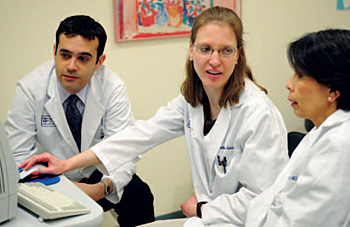

What are the costs of a clinical trial?
All medical care provided at the NEI medical facility in Bethesda, Md., is free of charge. Clinical trials conducted at other locations may involve costs related to standard medical care. These may or may not be covered by health insurance. You should discuss any possible costs with your healthcare provider and insurance company before enrolling in a clinical trial.
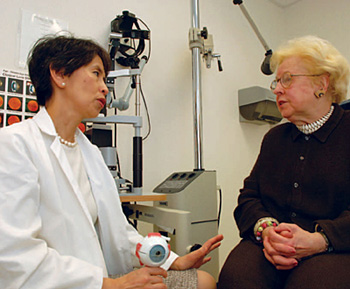
You have the right to know all of the risks and benefits of the treatment involved in the study.
A Volunteer’s Bill of Rights
As a participant in a clinical trial, you have the right to:
- Know all of the risks and benefits of the treatment involved in the study.
- Know how, for how long, and where the researchers plan to carry out the study.
- Know what is expected of you in the study.
- Know any costs involved for you or your insurance company.
- Be aware of any medical and personal information that is shared with other researchers who are directly involved with the study.
- Talk openly with doctors.
- Ask questions about the study.
- Leave the study at any time after enrolling. However, you should not enroll if you think you may be unable to complete the study.
- Receive any new information about the treatment that becomes available during the study.
- Be informed of your treatment assignment after the study is completed.
- Maintain your privacy even after your participation is completed. Your name should not appear in any reports based on the study.
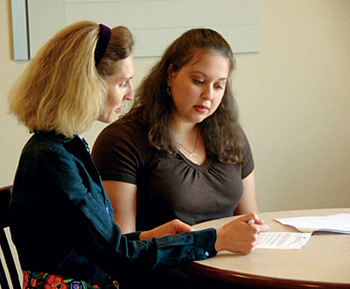
Talk with your doctors, family members, and clinical trial staff to determine whether a particular study is the right choice for you.
Questions to Ask Before Participating
It is important to completely understand the clinical trial before volunteering. Talk with your doctors, family members, and clinical trial staff to determine if a particular study is the right choice for you. Before deciding, be sure you know the answers to the following questions:
About the study:
- What is the purpose of this clinical trial?
- Why do researchers think the new treatment being studied may be better than the standard treatment?
- What is known about side effects from the treatment?
- What tests and treatment will I receive?
- Will I need surgery or medications?
- Will I be hospitalized?
- How will the study benefit me? How will it benefit others?
About your health:
- How might the treatment benefit my eye condition?
- What are the possible short- and long-term risks and side effects of the treatment?
- What are the chances of any side effects occurring?
- How will my health be monitored during the study?
- Who will be in charge of my care? Will I be able to see my own doctor?
About your commitment:
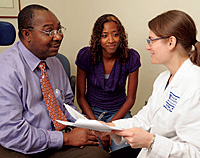
- Will taking part in the study affect my daily life?
- How long will the treatment last?
- How often will I need to return for follow-up exams?
- What is the total time involved?
- How much will it cost me to be in the study?
- How do I feel about taking part in a clinical trial? How do my family and friends feel about my participation?
Clinical Trials at NEI
The NEI Web site lists the clinical trials that are currently recruiting volunteers. This list includes studies taking place on the NIH campus in Bethesda, Md., and NEI-supported studies being conducted at clinical centers around the country. Eligibility criteria are included for each study.
For more information about enrolling in an NEI clinical trial, go to The Eye Clinic.
For more information about the NEI, contact:
National Eye Institute
2020 Vision Place
Bethesda, MD 20892-3655
nei2020@nei.nih.gov
301-496-5248
For more information about clinical trials, visit ClinicalTrials.gov.
